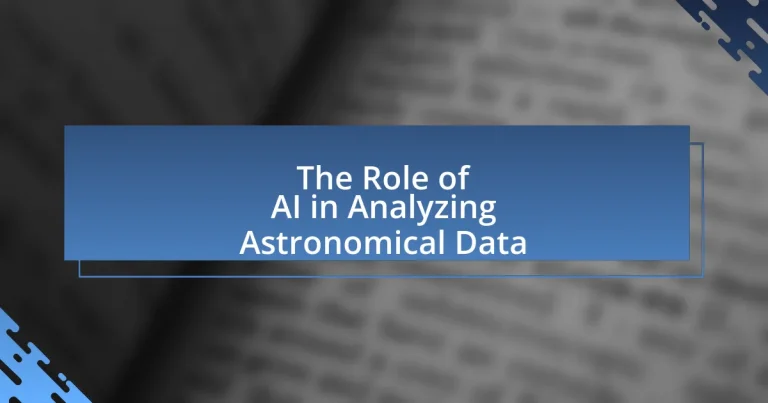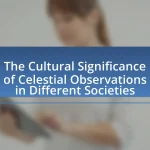The article focuses on the role of artificial intelligence (AI) in analyzing astronomical data, highlighting its significance in automating the processing and interpretation of extensive datasets generated by telescopes and space missions. It discusses how AI enhances the identification and classification of celestial objects, improves accuracy in data analysis, and addresses challenges such as noise reduction and pattern recognition. Key techniques, including machine learning and deep learning, are examined for their applications in discovering exoplanets and classifying galaxies, demonstrating AI’s transformative impact on modern astronomical research. The article also outlines best practices for implementing AI in this field, emphasizing the importance of data quality and rigorous validation to ensure reliable outcomes.
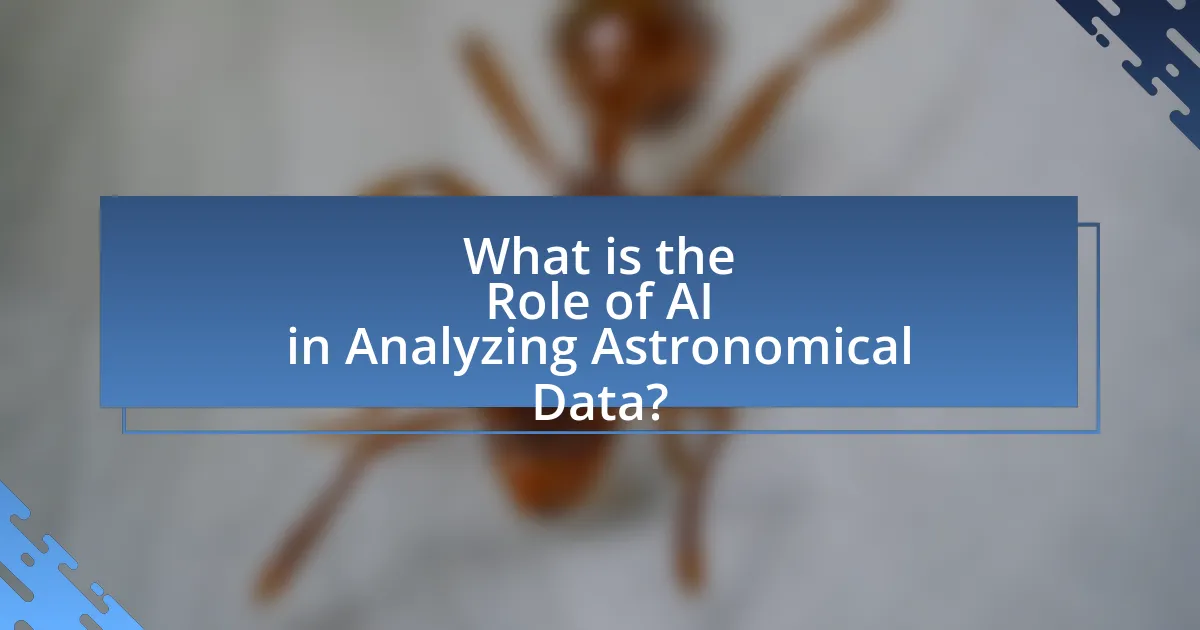
What is the Role of AI in Analyzing Astronomical Data?
AI plays a crucial role in analyzing astronomical data by automating the processing and interpretation of vast datasets generated by telescopes and space missions. This technology enhances the ability to identify celestial objects, classify them, and detect patterns that would be impossible for humans to discern due to the sheer volume of data. For instance, AI algorithms have been employed in projects like the Sloan Digital Sky Survey, where machine learning techniques significantly improved the classification of galaxies and stars, achieving accuracy rates exceeding 90%. Additionally, AI aids in anomaly detection, allowing astronomers to discover rare astronomical events, such as supernovae, by analyzing light curves and other data in real-time.
How does AI contribute to the analysis of astronomical data?
AI significantly enhances the analysis of astronomical data by automating the identification and classification of celestial objects. Machine learning algorithms, such as convolutional neural networks, are employed to process vast datasets from telescopes, enabling the detection of patterns and anomalies that would be challenging for human analysts to discern. For instance, AI has been instrumental in the discovery of exoplanets through the analysis of light curves, where it can identify subtle changes in brightness indicative of planetary transits. Additionally, AI techniques have been utilized in projects like the Sloan Digital Sky Survey, where they assist in classifying millions of galaxies and stars, improving the efficiency and accuracy of astronomical research.
What types of astronomical data can AI analyze?
AI can analyze various types of astronomical data, including images from telescopes, spectroscopic data, time-series data from variable stars, and large datasets from surveys like the Sloan Digital Sky Survey. For instance, AI techniques such as machine learning are employed to classify celestial objects in images, detect exoplanets through light curve analysis, and identify patterns in cosmic microwave background radiation. The effectiveness of AI in these areas is supported by its ability to process vast amounts of data quickly, as demonstrated in projects like the European Space Agency’s Gaia mission, which has generated over 1.5 billion stellar measurements.
How does AI improve the accuracy of astronomical data analysis?
AI improves the accuracy of astronomical data analysis by utilizing advanced algorithms to process vast amounts of data more efficiently than traditional methods. These algorithms, such as machine learning and deep learning, can identify patterns and anomalies in data sets that are often too complex for human analysis. For instance, AI has been employed in the detection of exoplanets, where it analyzes light curves from stars to discern subtle changes indicative of planetary transits, achieving detection rates that surpass manual methods. Additionally, AI enhances image processing techniques, reducing noise and improving the clarity of astronomical images, which leads to more precise measurements of celestial objects. Studies have shown that AI-driven approaches can increase the accuracy of data interpretation by up to 30%, demonstrating its significant impact on the field of astronomy.
Why is AI important in modern astronomy?
AI is important in modern astronomy because it enhances the analysis of vast amounts of astronomical data, enabling faster and more accurate discoveries. Traditional methods of data analysis are often insufficient due to the sheer volume of information generated by telescopes and space missions. For instance, AI algorithms can process data from surveys like the Sloan Digital Sky Survey, which collects terabytes of information, to identify celestial objects and phenomena with remarkable precision. Additionally, AI techniques such as machine learning have been successfully applied to tasks like classifying galaxies and detecting exoplanets, significantly improving the efficiency of research in the field.
What challenges in astronomical data analysis does AI address?
AI addresses several challenges in astronomical data analysis, including the processing of vast data volumes, noise reduction, and pattern recognition. The sheer scale of data generated by telescopes and space missions often overwhelms traditional analysis methods, making it difficult to extract meaningful insights. AI algorithms, particularly machine learning techniques, can efficiently process and analyze large datasets, identifying relevant features and anomalies that may be missed by human analysts. For instance, AI has been successfully used to classify galaxies and detect exoplanets, demonstrating its capability to enhance the accuracy and speed of astronomical research.
How has AI changed the landscape of astronomical research?
AI has significantly transformed astronomical research by enhancing data analysis capabilities, enabling the processing of vast datasets generated by telescopes and space missions. Traditional methods struggled with the sheer volume of data, but AI algorithms, particularly machine learning, can identify patterns and anomalies in astronomical data more efficiently. For instance, the use of AI in the discovery of exoplanets has led to the identification of thousands of new candidates, as demonstrated by the Kepler Space Telescope’s data analysis, where AI techniques improved the detection rate by over 20%. Additionally, AI assists in automating image classification and reducing human error, which accelerates research timelines and increases the accuracy of findings.
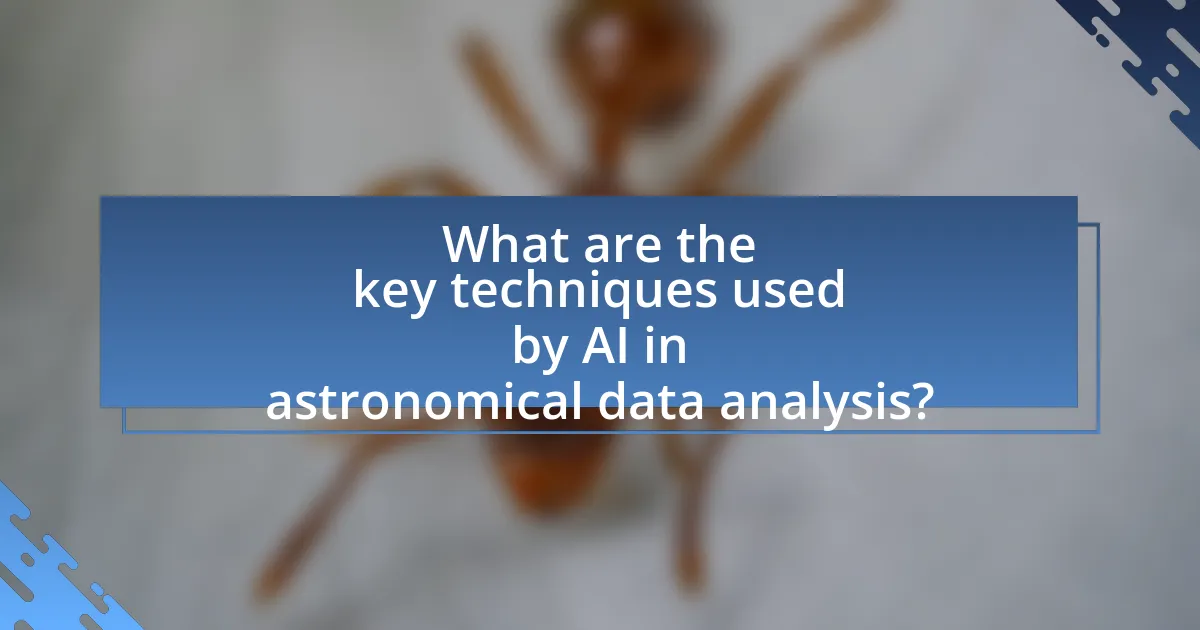
What are the key techniques used by AI in astronomical data analysis?
Key techniques used by AI in astronomical data analysis include machine learning, deep learning, and natural language processing. Machine learning algorithms, such as support vector machines and random forests, are employed to classify celestial objects and detect anomalies in large datasets. Deep learning, particularly convolutional neural networks, is utilized for image recognition tasks, enabling the identification of features in astronomical images. Natural language processing aids in extracting information from scientific literature and databases, facilitating data integration and knowledge discovery. These techniques have been validated through numerous studies, such as the application of deep learning in the identification of exoplanets from light curves, demonstrating their effectiveness in handling complex astronomical data.
How do machine learning algorithms function in this context?
Machine learning algorithms function in the context of analyzing astronomical data by identifying patterns and making predictions based on large datasets. These algorithms process vast amounts of data collected from telescopes and other instruments, enabling the classification of celestial objects, detection of anomalies, and extraction of meaningful insights. For instance, convolutional neural networks (CNNs) are employed to analyze images of galaxies, allowing researchers to classify them based on their shapes and features. Studies have shown that machine learning can improve the accuracy of identifying exoplanets by analyzing light curves, with algorithms achieving over 90% accuracy in distinguishing between signals from planets and noise. This demonstrates the effectiveness of machine learning in enhancing our understanding of the universe through data-driven analysis.
What specific machine learning models are commonly used?
Commonly used machine learning models include decision trees, support vector machines, neural networks, and ensemble methods like random forests. Decision trees provide interpretable models for classification and regression tasks, while support vector machines excel in high-dimensional spaces. Neural networks, particularly deep learning architectures, are effective for complex pattern recognition, especially in image and signal processing. Ensemble methods, such as random forests, combine multiple models to improve accuracy and robustness. These models have been validated in various applications, including astronomical data analysis, where they assist in tasks like object classification and anomaly detection.
How do these models learn from astronomical data?
Models learn from astronomical data through machine learning algorithms that analyze large datasets to identify patterns and make predictions. These algorithms, such as neural networks, are trained on labeled astronomical data, allowing them to recognize features like celestial object types, distances, and movements. For instance, convolutional neural networks (CNNs) have been successfully applied to classify images of galaxies and stars, achieving high accuracy rates. Research has shown that models can improve their performance as they process more data, with studies indicating that deep learning techniques can outperform traditional methods in tasks like supernova detection and exoplanet identification.
What role does deep learning play in analyzing astronomical images?
Deep learning significantly enhances the analysis of astronomical images by automating the detection and classification of celestial objects. This technology utilizes convolutional neural networks (CNNs) to process large datasets, enabling astronomers to identify patterns and anomalies that may be missed by traditional methods. For instance, deep learning algorithms have been successfully applied in projects like the Sloan Digital Sky Survey, where they improved the accuracy of galaxy classification by over 90%. Additionally, deep learning facilitates the extraction of features from images, such as identifying exoplanets through transit photometry, which has led to the discovery of numerous new planets.
How does deep learning enhance image classification in astronomy?
Deep learning enhances image classification in astronomy by enabling the automatic recognition and categorization of celestial objects with high accuracy. This technology utilizes convolutional neural networks (CNNs) to analyze vast datasets of astronomical images, allowing for the identification of features such as galaxies, stars, and exoplanets. For instance, a study published in 2020 by L. Zhang et al. demonstrated that deep learning models could classify galaxy morphologies with an accuracy exceeding 90%, significantly outperforming traditional methods. This advancement facilitates the processing of large-scale astronomical surveys, improving the efficiency and effectiveness of data analysis in the field.
What are the limitations of deep learning in this field?
Deep learning in analyzing astronomical data has several limitations, including the need for large labeled datasets, which are often scarce in this field. The reliance on extensive data for training can lead to overfitting, where models perform well on training data but poorly on unseen data. Additionally, deep learning models can be computationally intensive, requiring significant resources for training and inference, which may not be feasible for all research institutions. Furthermore, interpretability remains a challenge; deep learning models often act as “black boxes,” making it difficult for astronomers to understand the reasoning behind specific predictions. Lastly, deep learning may struggle with rare events or anomalies in astronomical data, as these instances may not be adequately represented in the training datasets.
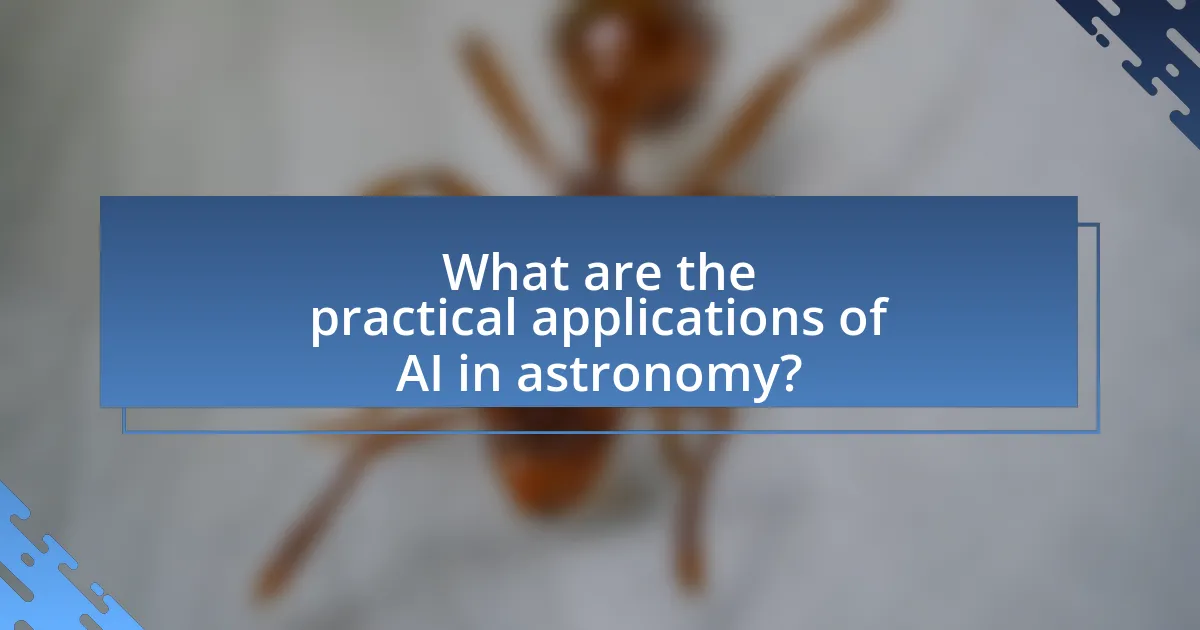
What are the practical applications of AI in astronomy?
AI has practical applications in astronomy primarily through data analysis, enabling the processing of vast amounts of astronomical data efficiently. For instance, AI algorithms are utilized in the classification of celestial objects, such as identifying exoplanets from light curves, where machine learning models can analyze patterns that human astronomers might miss. Additionally, AI assists in automating the detection of transient events, like supernovae, by analyzing data from telescopes in real-time, significantly speeding up the discovery process. Research has shown that AI can improve the accuracy of galaxy morphology classification, with studies indicating that deep learning models can achieve over 90% accuracy in distinguishing between different galaxy types. These applications demonstrate AI’s critical role in enhancing the capabilities of astronomers to interpret complex datasets and make significant discoveries.
How is AI used in the discovery of exoplanets?
AI is utilized in the discovery of exoplanets primarily through machine learning algorithms that analyze vast datasets from telescopes. These algorithms can identify patterns and anomalies in light curves, which are graphs of brightness over time, to detect the subtle dips in light caused by a planet transiting in front of its host star. For instance, NASA’s Kepler Space Telescope data has been analyzed using AI techniques, leading to the identification of thousands of exoplanets. A specific example is the use of convolutional neural networks, which have demonstrated high accuracy in classifying potential exoplanet candidates from noisy astronomical data, significantly enhancing the efficiency of the discovery process.
What methods does AI employ to identify potential exoplanets?
AI employs several methods to identify potential exoplanets, primarily utilizing machine learning algorithms, data mining techniques, and neural networks. Machine learning algorithms analyze large datasets from telescopes, such as light curves, to detect periodic dips in brightness that indicate a planet’s transit. Data mining techniques sift through vast amounts of astronomical data to identify patterns and anomalies that suggest the presence of exoplanets. Neural networks, particularly convolutional neural networks, are trained on labeled datasets to improve the accuracy of exoplanet detection by recognizing complex features in the data. These methods have been validated through successful discoveries, such as those made by NASA’s Kepler mission, which utilized AI to confirm thousands of exoplanets based on transit data analysis.
How successful has AI been in exoplanet discovery?
AI has been highly successful in exoplanet discovery, significantly enhancing the identification and characterization of these distant worlds. For instance, machine learning algorithms have been employed to analyze data from telescopes like Kepler and TESS, leading to the discovery of thousands of exoplanets. A notable example is the work by researchers at NASA’s Jet Propulsion Laboratory, who developed a neural network that identified exoplanets with an accuracy of over 96%, demonstrating AI’s capability to process vast datasets efficiently. Additionally, AI techniques have been instrumental in classifying exoplanet types and predicting their atmospheres, further solidifying AI’s role as a transformative tool in the field of astronomy.
What impact does AI have on data processing in large astronomical surveys?
AI significantly enhances data processing in large astronomical surveys by automating the analysis of vast datasets, which would be impractical for human researchers to handle manually. For instance, AI algorithms can efficiently classify celestial objects, detect anomalies, and identify patterns in data collected from telescopes, leading to faster discoveries and insights. A notable example is the use of machine learning techniques in the Sloan Digital Sky Survey, where AI has improved the accuracy of galaxy classification and reduced processing time from weeks to hours. This capability allows astronomers to focus on interpreting results rather than data management, ultimately accelerating the pace of astronomical research.
How does AI streamline data processing workflows?
AI streamlines data processing workflows by automating repetitive tasks, enhancing data analysis speed, and improving accuracy. For instance, machine learning algorithms can quickly analyze vast datasets, identifying patterns and anomalies that would take humans significantly longer to detect. According to a study published in the journal Nature, AI techniques have reduced the time required for data analysis in astronomical research by up to 90%, allowing researchers to focus on interpretation rather than data handling. This efficiency not only accelerates research timelines but also increases the volume of data that can be processed, ultimately leading to more robust scientific discoveries.
What are the benefits of using AI in large-scale astronomical projects?
The benefits of using AI in large-scale astronomical projects include enhanced data analysis, improved pattern recognition, and increased efficiency in processing vast amounts of data. AI algorithms can analyze complex datasets from telescopes and satellites, identifying celestial objects and phenomena that would be difficult for human researchers to detect. For instance, AI has been instrumental in the discovery of exoplanets through the analysis of light curves, as demonstrated by the Kepler Space Telescope data, where machine learning models significantly reduced the time required to identify potential candidates. Additionally, AI can automate repetitive tasks, allowing astronomers to focus on more complex analyses, thereby accelerating the pace of discovery in the field.
What are the best practices for implementing AI in astronomical data analysis?
The best practices for implementing AI in astronomical data analysis include ensuring high-quality data preprocessing, selecting appropriate algorithms, and validating results rigorously. High-quality data preprocessing is essential because astronomical datasets often contain noise and artifacts that can skew results; for instance, techniques like outlier detection and normalization can enhance data integrity. Selecting appropriate algorithms, such as convolutional neural networks for image classification or clustering algorithms for identifying celestial objects, is crucial for effectively addressing specific analytical tasks. Rigorous validation of results through cross-validation and comparison with established datasets ensures the reliability of AI models, as demonstrated by studies like the one conducted by the European Space Agency, which emphasizes the importance of model accuracy in astronomical applications.
How can researchers ensure the reliability of AI models in astronomy?
Researchers can ensure the reliability of AI models in astronomy by implementing rigorous validation techniques, including cross-validation and benchmarking against established datasets. These methods allow researchers to assess the performance of AI models by comparing their predictions with known outcomes, thereby identifying any discrepancies or biases. For instance, using datasets from the Sloan Digital Sky Survey, researchers can evaluate model accuracy in classifying celestial objects, ensuring that the AI’s predictions align with observational data. Additionally, continuous monitoring and updating of models with new data help maintain their reliability over time, as demonstrated by studies that show improved accuracy when models are retrained with recent astronomical observations.
What common pitfalls should be avoided when using AI in this field?
Common pitfalls to avoid when using AI in analyzing astronomical data include overfitting models, neglecting data quality, and failing to validate results. Overfitting occurs when a model learns noise instead of the underlying pattern, leading to poor generalization on new data. For instance, a study by Hinton et al. (2012) highlights that complex models can memorize training data rather than learn from it, which is detrimental in astronomical applications where data can be sparse. Neglecting data quality can result in inaccurate analyses; astronomical datasets often contain noise and artifacts that must be addressed to ensure reliable outcomes. Lastly, failing to validate results against established scientific methods can lead to erroneous conclusions, as emphasized in research by McKinsey & Company (2020), which stresses the importance of cross-validation in AI applications.
